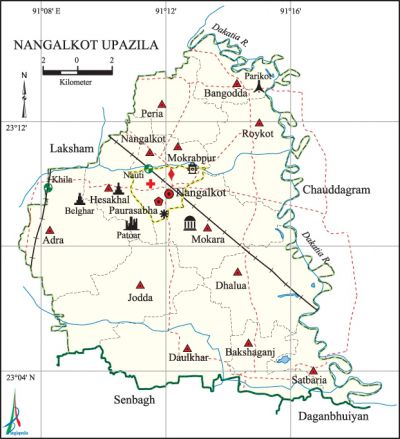Nangalkot Upazila
Nangalkot Upazila (comilla district) area 225.95 sq km, located in between 23°02' and 23°14' north latitudes and in between 91°'07' and 91°18' east longitudes. It is bounded by laksham and chauddagram upazilas on the north, senbagh and daganbhuiyan upazilas on the south, Chauddagram upazila on the east, Laksham upazila on the west.
Population Total 373987; male 171450, female 202537; Muslim 369476, Hindu 4490, Buddhist 10, Christian 7 and others 4.
Water bodies Main river: dakatia.
Administration Nangalkot Thana was turned into an upazila in 1983.
| Upazila | ||||||||
| Municipality | Union | Mouza | Village | Population | Density (per sq km) | Literacy rate (%) | ||
| Urban | Rural | Urban | Rural | |||||
| - | 12 | 193 | 270 | 26719 | 347268 | 1655 | 52.6 | 51.1 |
| Municipality | ||||||||
| Area (sq km) |
Ward | Mahalla | Population | Density (per sq km) |
Literacy rate (%) | |||
| 13.06 | 9 | 21 | 26719 | 2046 | 52.6 | |||
| Union | ||||
| Name of union and GO code | Area (acre) | Population | Literacy rate (%) | |
| Male | Female | |||
| Adra 11 | 4738 | 17469 | 20141 | 52.2 |
| Jodda 60 | 6471 | 18937 | 22880 | 50.4 |
| Dhalua 43 | 6189 | 14804 | 17574 | 50.2 |
| Daulkhar 51 | 5549 | 18912 | 23387 | 50.5 |
| Peria 80 | 3659 | 12431 | 14521 | 56.3 |
| Bakshaganj 34 | 3159 | 10211 | 12464 | 52.9 |
| Bangodda 17 | 3199 | 11352 | 13228 | 56.8 |
| Mokrabpur 73 | 2975 | 8973 | 10588 | 52.3 |
| Mokara 69 | 4987 | 14449 | 17459 | 49.5 |
| Roykot 86 | 6359 | 17973 | 21195 | 47.8 |
| Satbaria 94 | 2250 | 3539 | 4303 | 56.3 |
| Hesakhal 57 | 2383 | 9434 | 11044 | 43.1 |
Source Bangladesh Population Census 2011, angladesh Bureau of Statistics.

Archaeological heritage and relics Old Kella (fort) at Patoari Dighi.
War of Liberation During the war of liberation Nangalkot upazila was under Sector 2. The Pak army killed 11 innocent persons at Tejer Bazar of the upazila. Besides, the local razakars killed one freedom fighter openly and buried him at a place near the Hasnpur Railway Station. Freedom fighters of the upazila had an encounter with the Pak army at Battali Bazar of the upazila. The enemies were defeated and had to flee. Mass graves were discovered at two places of the upazila (Parikot and Tejer Bazar) and 2 memorial monuments were built.
For details: see নাঙ্গলকোট উপজেলা, বাংলাদেশ মুক্তিযুদ্ধ জ্ঞানকোষ (Encyclopedia of Bangladesh War of Liberation), বাংলাদেশ এশিয়াটিক সোসাইটি, ঢাকা ২০২০, খণ্ড ৫।
Religious institutions Mosque 650, temple 6. Noted religious institutions: Nangalkot Bara Mosque, Jami Mosque at Khandkar Bari, Mokara Shahi Jami Mosque, Tilip Jami Mosque, Shree Shree Kali Mandir at Hesakhal, Belghar Mandir, Ohiajora Kali Mandir.
Literacy rate and educational institutions Average literacy 51.2%; male 49.7%, female 52.4%. Educational institutions: college 9, technical college 3, secondary school 43, primary school 131, satellite primary school 39, madrasa 34. Noted educational institutions: Hasan Memorial Degree College (1984), Chalan College (1985), Homnabad Model College (1985), Bholain College (1995), Mayura' High School (1916), Daulkhar High School (1929), Nangalkot AR Multilateral High School (1941), Autistic School (1988),' Badsha Mia High School, Mandali High School, Shaktali High School, Patoari Senior Madrasa, Nangalkot AU Kalim Madrasa.
Newspapers and periodicals Weekly: Nangalkot Barta (irregular).
Cultural organisations Library 3, club 102, playground 10, theatre stage 1.
Main sources of income Agriculture 45.72%, non-agricultural labourer 3.15%, industry 0.79%, commerce 12.54%, transport and communication 2.91%, service 14.39%, construction 1.42%, religious service 0.46%, rent and remittance 8.42% and others 10.20%.
Ownership of agricultural land Landowner 63.13%, landless 36.87%; agricultural landowner: urban 60.07% and rural 63.19%.
Main crops Paddy, wheat, potato, maize, kalai, vegetables.
Extinct or nearly extinct crops Sesame, linseed, kaun, mulberry, betel leaf, arahar.
Main fruits Mango, jackfruit, litchi, banana, pineapple, watermelon, kamranga.
Fisheries, dairies and poultries Hatchery and fish marketing centre 11, poultry 10, nursery 11, cattle breeding centre 15.
Communication facilities Pucca road 325.94 km, semi-pucca road 29.75 km, mud road 452.83 km; railway 19 km; waterway 7.88 km; culvert 724, bridge 23.
Extinct or nearly extinct traditional transport Palanquin, bullock cart, horse carriage.
Noted manufactories Rice mill, ice factory, brick-field.
Cottage industries Goldsmith, blacksmith, potteries, weaving, embroidery, wood work, bamboo work, cane work.
Hats, bazars and fairs Hats and bazars are 40, fairs 4, most noted of which are Nangalkot Bazar, Omarganj Bazar, Charia Bazar, Boxganj Bazar, Jodda Daulkhar Bazar, Dhalua Bazar, Mahini Bazar, Hesakhal Bazar, Dayemchadi Bazar and Paush Samkranti Mela at Mokara Village, Baishakhi Mela at Azizia.
Access to electricity All the unions of the upazila are under rural electrification net-work. However 49.9% of the dwelling households have access to electricity.
Sources of drinking water Tube-well 91.7%, tap 1.1% and others 7.2%. The presence of arsenic has been detected in shallow tube-well water of the upazila.
Sanitation 75.2% of dwelling households of the upazila use sanitary latrines and 20.8% of dwelling households use non-sanitary latrines; 4.0% of households do not have latrine facilities.
Health centres Hospital 2, family planning centre 11, satellite clinic 3, community health centre 42, EPI centre 24, clinic 2, mental hospital 1, mother and child welfare centre 1.
Natural disasters The floods of 1958, 1998 and 2002 inundated the vast area and also caused heavy damages to settlements, communication and crops of the upazila.'
NGO activities Operationally important NGOs are brac, asa, Manab Kalyan Sangstha. [Md. Mobashwer Hussain]
References Bangladesh Population Census 2001 and 2011, Bangladesh Bureau of Statistics; Cultural survey report of Nangalkot Upazila 2007.
